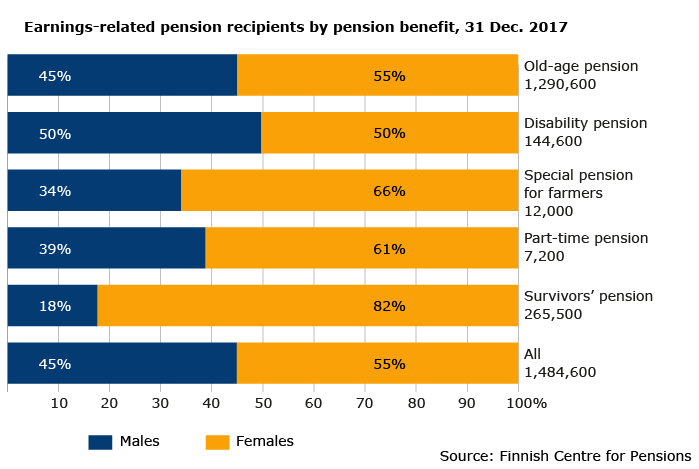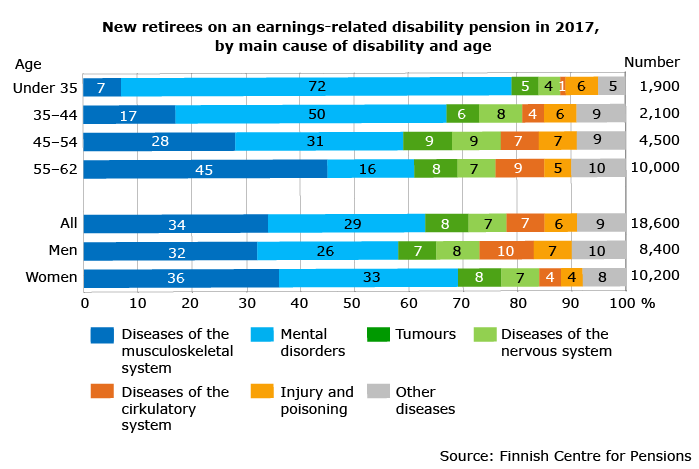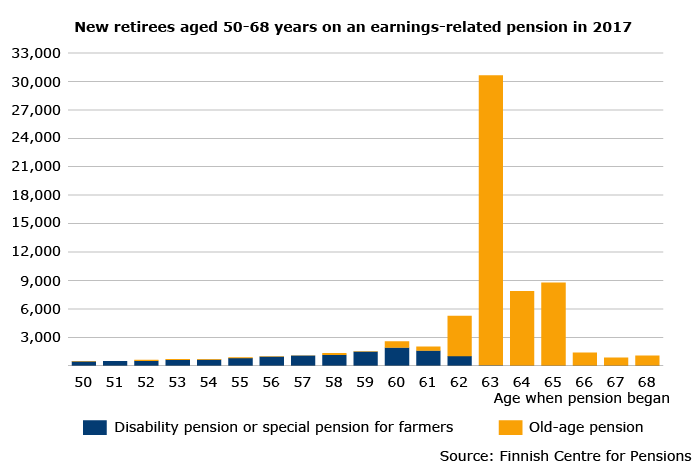Earnings-related pension recipients in Finland 2017
A more recent publication of this set of statistics is available: Earnings-related pension recipients in Finland
Women account for more than half of Finland’s earnings-related pensioners

At year-end 2017 the number of earnings-related pensioners in Finland reached 1,485,000, up 28,000 from the year before. The increase was driven by the rising number of old-age pension recipients; the number of people receiving other pension benefits declined from 2016.
The great majority of pension payments went to people living in Finland: 1,450,000 of all earnings-related pensioners lived in Finland, 35,000 lived abroad. Women accounted for more than half (55%) of all earnings-related pension recipients.
A total of 1,443,000 persons received a pension based on their work history, that is, an old-age, disability, part-time or farmers’ special pension. Furthermore, 266,000 persons received a survivors’ pension: 253,000 surviving spouses and 13,000 children.
Most earnings-related pensioners received an old-age pension. The total number of old-age pension recipients was 1,290,000, of whom 11,700 took out a partial early old-age pension. In this latter group women accounted for 42 per cent.
Underlying reasons for retirement on a disability pension vary by age groups

In 2017, a total of 18,600 persons retired from the earnings-related pension system on a disability pension. 10,200 were women (55%) and 8,400 men (45%). More than half of all new retirees were 55 years or more, while a quarter of them were aged 45-54 years. The under-45-year-olds accounted for around 20 per cent of all new retirees on a disability pension.
More than one third (34%) of all new retirees on a disability pension retired due to diseases of the musculoskeletal system. The second most common cause (29%) for retirement on a disability pension was mental and behavioural disorders. All other main disease categories accounted for less than 10 per cent each.
When reviewed by age group, the causes for disability clearly differ. More than two thirds (72%) of all new disability retirees aged under 35 years suffered from mental and behavioural disorders. The equivalent ratio for the 35-44-year-olds was half. Of all new disability retirees aged 55 and more, 45 per cent suffered from a musculoskeletal disease and only 16 per cent from mental and behavioural disorders.
Musculoskeletal diseases and mental and behavioural disorders caused the disability for 70 per cent of the new female disability pension retirees and for less than 60 per cent of the new male disability pension retirees. Men retired on a disability pension more often than women because of diseases of the circulatory system and injuries and poisoning.
At year-end 2017, about 145,000 persons got a disability pension under the earnings-related pension. For more than two fifths (42%), the disability was caused by mental and behavioural disorders and for one quarter (26%) by diseases of the musculoskeletal system. People who retire on a disability pension due to mental and behavioural disorders are, on average, younger than those who retire due to a musculoskeletal disease. That is why disability pensions due to mental and behavioural disorders are paid for a much longer time than those due to diseases of the musculoskeletal system. In 2017, the average age for those who retired on a disability pension due to mental and behavioural disorders was 45 years, while it was 56 years for those who retired due to musculoskeletal diseases.
Most people retire at age 63

In 2017, roughly 75,400 persons retired on an earnings-related pension. This was slightly fewer than in 2016.
The majority of the new retires, ca 56,600 persons, retired on an old-age pension. Most people retired on an old-age pension at age 63. In addition, about 12,500 persons retired on a partial old-age pension in 2017.
Earnings-related disability pensions were paid to 18,600 new retirees. The number of new retirees on a disability pension has remained unchanged in the last few years, but the share of retirees on a part-time disability pension has grown.
Quality description: Pensioners in Finland 2017
The statistics Earnings-related pensioners in Finland is published by the Finnish Centre for Pensions.
The Act on the Finnish Centre for Pensions states that the responsibilities of the institution include, for example, the compiling of statistics in its field of operation. The production of the statistics at the Finnish Centre for Pensions is handled by the Planning Department.
The Earnings-related pensioners in Finland is financed by the Finnish Centre for Pensions.
Relevance of statistical information
Statutory pension security in Finland consists primarily of two pension schemes: the earnings-related pension scheme and the national pension scheme. The pensions of the former scheme are based on earnings, while the pensions of the latter scheme are residence-based. Earnings-related pensioners in Finland provides an overview of the pensions paid within the Finnish earnings-related pension scheme.
In the private sector, the earnings-related pension provision is administered by earnings-related pension insurance companies, industry-wide pension funds and company pension funds. The Finnish Centre for Pensions is the central body of the earnings-related pension scheme. One of its assignments is to collect the information required for the administration of earnings-related pension matters for the purpose of handling the tasks prescribed to it.
Earnings-related pensioners in Finland covers the whole statutory earnings-related pension provision, as well as voluntary registered supplementary pension provision financed by the employer. Voluntary non-registered supplementary pensions paid by the employer are not included in the figures of these statistics, nor voluntary pension provision paid by the individuals themselves. In addition, the statistics do not include pensions from the national pension scheme and pension from workers compensation, motor liability and military accident insurance, so-called SOLITA pensions.
The statistics contain figures on the number and median pensions of earnings-related pension recipients and new retirees on an earnings-related pension as at the end of the year. The statistics also contain information on earnings-related pension expenditure, earnings-related pensions paid abroad and disability pension decisions.
The main classifier in the statistics is the division of the earnings-related pension scheme into the private and the public sector. In addition, the following classifications are used in the statistics: pension benefit, pension size, gender and age. Disability pensions are classified by disease category. The regional classification for the earnings-related pension expenditure is based on the Finnish regions (http://stat.fi/meta/luokitukset/maakunta/001-2015/index_en.html). Pension recipients abroad are classified by country of residence and country groups.
The country groups are defined in Appendix 2 of Earnings-related pensioners in Finland 2015, page 104 at https://www.etk.fi/en/publications/. The concepts and definitions used in the statistics are presented on the website of the statistics, at https://www.etk.fi/statistics> Pension recipients and insured > Earnings-related pension recipients.
The statistics serves social security specialists, researchers and the media, as well as others requiring information about this field. Equally comprehensive statistical data on Finnish pension recipients is not available elsewhere.
Correctness and accuracy of data
The data of this statistical publication is based on data in the pension register (composite data). The register contains registered data from pension decisions. The data is used to form pension periods and pensions which are registered in the statistics register. This statistics register forms the basis for pension statistics.
The regional data presented in the statistics is based on Kela’s population data. It is supplemented on the basis of the country of tax at source for pensions paid abroad, as reported by the pension providers.
Together with the earnings-related pension providers, the Register Services Department of the Finnish Centre for Pensions is responsible for the contents of the registers, the accessibility, scope, legality and accuracy of the data needed for the implementation of pension provision and the clarification of error conditions in the contents. The handling systems include authenticity and logical checks where the programme requires correction or verification of data. The error messages may also be comments that do not inhibit the registration of data. Arek Oy is responsible for the information technology aspects of the registers.
Arek Oy is a company jointly owned by the pension providers and the Finnish Centre for Pensions.
Flaws detected in the statistics are immediately corrected on the website. In connection with the correction, information on the content and time of the correction is provided. A correction page is added to printed publications that have not yet been distributed. If the error is substantial, a separate bulletin is issued for those who have already received the printed publication.
Timeliness and promptness of published data
Earnings-related pensioners in Finland is published once a year during the first half of the year following the statistical year. The date of publication of the statistics is presented in the Release Calendar on the website of the Finnish Centre for Pensions at www.etk.fi/statistics, section ‘Release Calendar’. The data in the statistics is final.
Coherence and comparability of data
This statistical publication has been produced since 1996. Its time series are mainly comparable from that date. As for the number of earnings-related pension recipients, the time series extends back to the year 1979.
From the beginning, the statistics has covered the numbers of earnings-related pension recipients and new retirees, the mean pensions, as well as the pension expenditure of the earnings-related pension scheme. Over the years, the data content of the statistics has been extended. Data on disability pension decisions in the earnings-related pension scheme was added in 2007.
In 2005—2013, the statistics was published under the name Pensioners and Insured in Finland. As of the statistical year 2014, the data is published in two different statistical publications: Earnings-related pensioners in Finland and Persons insured for an earnings-related pension in Finland.
In 1999, the concept of new retirees was changed. It no longer included persons retiring on a part-time pension. Persons receiving a part-time pension are included in the figures for new retirees when they start to receive some other pension that is based on their own working life, usually an old-age pension. In 1996–1998, new part-time pensioners were counted as pensioners on an earnings-related pension. As of the 1999 statistics, the time series of earnings-related pension retirees have been corrected retroactively. Thus, the 1996-1998 statistics are not comparable in this respect with those of later years.
The partial old-age pension, introduced in 2017, is processed in the same way in the statistics as the part-time pension. That means that persons who have retired on a partial old-age pension in 2017 are not considered new retirees.
The following changes have been made to concepts and classifiers based on legal amendments and feedback from users:
- Following the 2005 legal reform, pensions are no longer categorized according to how maximal they are.
- Since 2005, disability pensions have been divided into full and partial pensions.
The statistics use applicable general standard categorizations, e.g. by disease (ICD-10) and region (province, country or residence and country group).
In cooperation with Kela, the Finnish Centre for Pensions produces Statistics on Finnish Pensioners. It covers the pensions of both the earnings-related and the national pension schemes. The figures on recipients of an earnings-related pension, new retirees on an earnings-related pension and earnings-related pension expenditure in those statistics are consistent with the figures in these statistics.
Availability and clarity of data
The statistical data is published annually in Earnings-related pensioners in Finland. The publication is available in print and online at the website of the Finnish Centre for Pensions. Instructions on how to order the printed publication can be found on the inside of the title page of the printed statistics and on the website of the Finnish Centre for Pensions. Some of the data in the statistics is also published in the statistical database of the Finnish Centre for Pensions, at www.etk.fi/statistics > Statistical Database. A description of the statistics has been presented on the website of the Finnish Centre for Pensions, at www.etk.fi/statistics > Pension recipients and insured > Earnings-related pension recipients.
The statistical service of the Finnish Centre for Pensions provides additional information about the statistics upon request per e-mail at tilastot(at)etk.fi.